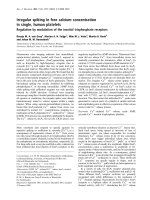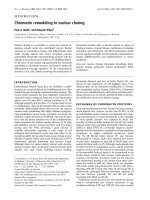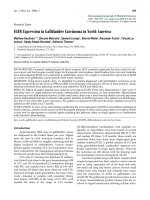Báo cáo y học: "Myocardial protection in sepsis" potx
Bạn đang xem bản rút gọn của tài liệu. Xem và tải ngay bản đầy đủ của tài liệu tại đây (39.91 KB, 2 trang )
Page 1 of 2
(page number not for citation purposes)
Available online />Abstract
Sepsis with myocardial dysfunction is seen commonly. Beta-
blockers have been used successfully to treat chronic heart failure
based on the premise that chronically elevated adrenergic drive is
detrimental to the myocardium. However, recent reports on the
acute use of beta-blockers in situations with potential hemodynamic
compromise have shown the risks associated with this approach. In
critical situations, the main effect of adrenergic activation is to
support cardiovascular function. Caution should be exercised in
designing studies to assess beta-blockers in septic patients.
Can β-blockers improve outcomes in septic patients with
myocardial depression? In the previous issue of Critical Care,
Schmittinger and colleagues [1] discuss the results of
treating myocardial depression in septic shock patients with
the combination of milrinone and metoprolol. They report on a
retrospective cohort of 40 patients. All were intubated and
70% were dialyzed. Support included volume infusion,
treatment with milrinone (a phosphodiesterase inhibitor) and
rapid addition of norepinephrine then vasopressin (31 of 40
patients) based on hemodynamic measurements. Metoprolol,
a β1-selective adrenergic antagonist, was given enterally at
low doses (25 to 47.5 mg/day). Over 96 hours of follow-up,
inotropic and vasopressor doses decreased, heart rate
decreased, and cardiac output remained stable. Lactate, pH,
creatinine, and C-reactive protein improved.
The study limitations are noted by the authors. Specifically, on
metoprolol, norepinephrine and milrinone dosages had to be
increased in 22.5% and 15% of patients, respectively.
Vasopressin was added in five patients. The safety of this
strategy cannot be assessed without a control group. Dialysis
makes interpreting creatinine changes difficult and the use of
a linear mixed effects model for analysis can lead to less
accurate type 1 error rates in small sample sizes. Despite
these limitations, this remains an interesting study. This is one
of the first trials to suggest the feasibility of acutely treating
myocardial depression from sepsis with adrenergic
antagonists. Despite advances in the care of septic patients,
mortality remains very high, especially when myocardial
depression occurs. New care strategies and therapies are
needed.
Myocardial injury and depression are common during sepsis
and are likely multi-factorial in etiology. The adrenergic nervous
system is activated in sepsis and pharmacological doses of β-
agonists are commonly utilized during goal directed therapy to
support oxygen delivery and maintain perfusion pressure [2,3].
There is a large body of evidence suggesting that excessive
adrenergic levels can cause myocardial damage [4].
Transgenic animals with overexpression of genes involving
adrenergic signaling develop myocardial apoptosis, fibrosis,
contractile dysfunction and eventually left ventricular dilatation.
In cell culture, catecholamines have been shown to cause
myocardial cell death and induce maladaptive changes in gene
expression. Severe head injury causes massive adrenergic
discharge resulting in myocardial necrosis and cardiac
dysfunction. In chronic heart failure, activation of the adrenergic
nervous system is associated with increased mortality, and
inotropic therapy worsens outcomes [5]. In contrast, β-blockers
have been shown to improve mortality in chronic heart failure
[6]. In general β-blockers are well tolerated even in severe heart
failure when started at a low dose.
Recent large prospective trials would mandate caution when
using β-blockers in acute settings of hemodynamic com-
promise. The COMMIT trial in acute myocardial infarction
showed that metoprolol’s benefit in reducing reinfarction and
arrhythmia (10 per 1,000) was offset by an increase in
cardiogenic shock (11 per 1,000) [7]. This was most
prominent in the first day of therapy in elderly patients with
tachycardia and low blood pressure, a population reminiscent
of the one discussed in the current series. The POISE trial
showed that metoprolol, started 2 to 4 hours before surgery
in high risk cardiac patients, led to increased rates of death
and stroke [8]. The rates of myocardial infarction were
reduced. Hypotension was very instrumental in causing the
adverse events. Interestingly, sepsis and infection were also
clearly more common on metoprolol.
Commentary
Myocardial protection in sepsis
Simon Shakar and Brian D Lowes
Division of Cardiology, University of Colorado Denver, Aurora, CO 80045, USA
Corresponding author: Simon Shakar,
Published: 3 September 2008 Critical Care 2008, 12:177 (doi:10.1186/cc6978)
This article is online at />© 2008 BioMed Central Ltd
See related research by Schmittinger et al., />Page 2 of 2
(page number not for citation purposes)
Critical Care Vol 12 No 5 Shakar and Lowes
Myocardial depression with β-blockers could explain the need
to escalate therapy with vasoactive drugs in the current
series. Gore and colleagues [9] showed that esmolol acutely
reduced cardiac output by 20% in septic patients. There was
also a reduction in blood pressure and oxygen delivery. Kukin
and colleagues [10] studied low dose β-blockers in chronic
heart failure patients. They found that even 6.25 mg of
metoprolol, given orally, acutely decreased cardiac output,
stroke volume and stroke work index. After 3 months and
uptitration to 50 mg bid, the administration of the drug con-
tinued to cause a decrease in cardiac output and stroke work
index. The use of inotropes to bridge patients to β-blockade
has only been reported in small heart failure studies [11].
Based on the above safety concerns, this strategy should be
considered experimental until further randomized controlled
studies are conducted. The reported incidence of hypo-
tension and decreased cardiac output is high enough that it
might cancel the potential metabolic and anti-adrenergic
benefits of metoprolol. The likelihood that the changes
observed in hemodynamic parameters are not due to
metoprolol is high. This was noted by the authors and
discussed above. If further studies are planned, smaller doses
of metoprolol should be considered in dose ranging trials.
The results seen with metoprolol should not be generalized to
other β-blockers. Carvedilol and nebivolol have vasodilatory
properties that could precipitate vascular collapse in this
patient population. Non-selective β-blockers such as esmolol
and propranolol may withdraw excessive adrenergic support
and precipitate worsening myocardial function.
Competing interests
The authors declare that they have no competing interests.
References
1. Schmittinger CA, Dünser MW, Haller M, Ulmer H, Luckner G,
Torgersen C, Jochberger S, Hasibeder WR: Combined milri-
none and enteral metoprolol therapy in patients with septic
myocardial depression. Crit Care 2008, 12:R99.
2. Russell JA: Management of sepsis. N Engl J Med 2006, 355:
1699-1713.
3. Rivers E, Nguyen B, Havstad S, Ressler J, Muzzin A, Knoblich B,
Peterson E, Tomlanovich M: Early goal-directed therapy in the
treatment of severe sepsis and septic shock. N Engl J Med
2001, 345:1368-1377.
4. Mann DL, Bristow MR: Mechanisms and models in heart
failure: the biomechanical model and beyond. Circulation
2005, 111:2837-2849.
5. Oliva F, Latini R, Politi A, Staszewsky L, Maggioni AP, Nicolis E,
Mauri F: Intermittent 6-month low-dose dobutamine infusion
in severe heart failure: DICE multicenter trial. Am Heart J
1999, 138:247-253.
6. Packer M, Bristow MR, Cohn JN, Colucci WS, Fowler MB, Gilbert
EM, Shusterman NH: The effect of carvedilol on morbidity and
mortality in patients with chronic heart failure. U.S. Carvedilol
Heart Failure Study Group. N Engl J Med 1996, 334:1349-
1355.
7. Chen ZM, Pan HC, Chen YP, Peto R, Collins R, Jiang LX, Xie JX,
Liu LS: Early intravenous then oral metoprolol in 45,852
patients with acute myocardial infarction: randomised
placebo-controlled trial. Lancet 2005, 366:1622-1632.
8. POISE Study Group, Devereaux PJ, Yang H, Yusuf S, Guyatt G,
Leslie K, Villar JC, Xavier D, Chrolavicius S, Greenspan L, Pogue
J, Pais P, Liu L, Xu S, Málaga G, Avezum A, Chan M, Montori VM,
Jacka M, Choi P: Effects of extended-release metoprolol succi-
nate in patients undergoing non-cardiac surgery (POISE trial):
a randomised controlled trial. Lancet 2008, 371:1839-1847.
9. Gore DC, Wolfe RR: Hemodynamic and metabolic effects of
selective beta1 adrenergic blockade during sepsis. Surgery
2006, 139:686-694.
10. Kukin ML, Kalman J, Mannino MM, Buchholz-Varley C, Ocampo
O: Beta blockade in congestive heart failure: persistent
adverse haemodynamic effects during chronic treatment with
subsequent doses. Heart 1997, 78:444-449.
11. Shakar SF, Abraham WT, Gilbert EM, Robertson AD, Lowes BD,
Zisman LS, Ferguson DA, Bristow MR: Combined oral positive
inotropic and beta-blocker therapy for treatment of refractory
class IV heart failure. J Am Coll Cardiol 1998, 31:1336-1340.









